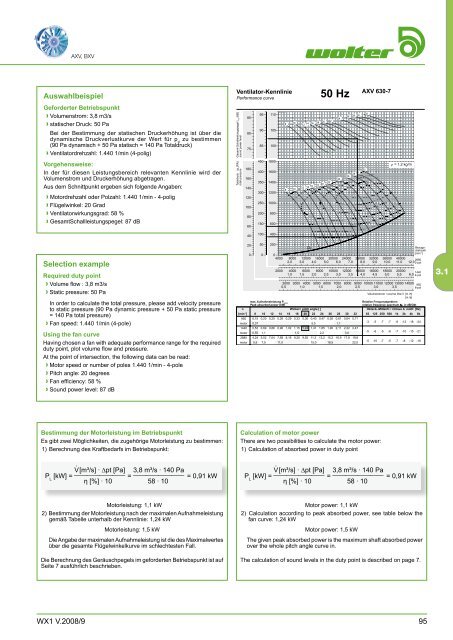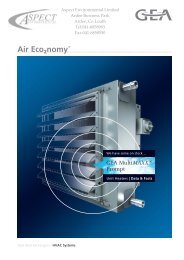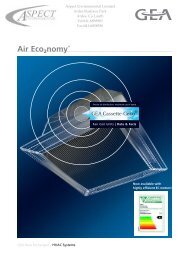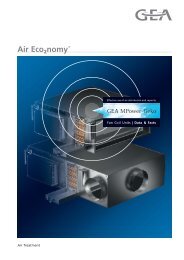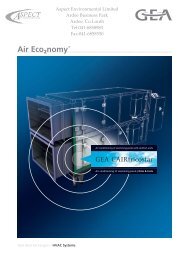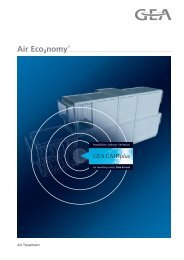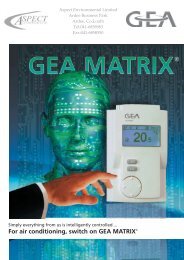Axialventilatoren - Aspectenvironmental.com
Axialventilatoren - Aspectenvironmental.com
Axialventilatoren - Aspectenvironmental.com
Erfolgreiche ePaper selbst erstellen
Machen Sie aus Ihren PDF Publikationen ein blätterbares Flipbook mit unserer einzigartigen Google optimierten e-Paper Software.
AXV, BXV<br />
!"<br />
Auswahlbeispiel<br />
Geforderter Betriebspunkt<br />
> Volumenstrom: 3,8 m3/s<br />
> statischer Druck: 50 Pa<br />
Bei der Bestimmung der statischen Druckerhöhung ist über die<br />
dynamische Druckverlustkurve der Wert für p d<br />
zu bestimmen<br />
(90 Pa dynamisch + 50 Pa statisch = 140 Pa Totaldruck)<br />
> Ventilatordrehzahl: 1.440 1/min (4-polig)<br />
Vorgehensweise:<br />
In der für diesen Leistungsbereich relevanten Kennlinie wird der<br />
Volumenstrom und Druckerhöhung abgetragen.<br />
Aus dem Schnittpunkt ergeben sich folgende Angaben:<br />
> Motordrehzahl oder Polzahl: 1.440 1/min - 4-polig<br />
> Flügelwinkel: 20 Grad<br />
> Ventilatorwirkungsgrad: 58 %<br />
> GesamtSchallleistungspegel: 87 dB<br />
Ventilator-Kennlinie<br />
Performance curve<br />
Gesamt-Schalleistungspegel L W [dB]<br />
sound power level<br />
Totaldruck p t [PA]<br />
total pressure<br />
85<br />
80<br />
75<br />
180<br />
160<br />
140<br />
120<br />
100<br />
80<br />
60<br />
95<br />
90<br />
85<br />
450<br />
400<br />
350<br />
300<br />
250<br />
200<br />
150<br />
110<br />
105<br />
100<br />
1800<br />
1600<br />
1400<br />
1200<br />
1000<br />
800<br />
600<br />
AXV630G<br />
8<br />
10<br />
8 10<br />
50 Hz<br />
AXV 630-7<br />
30 32<br />
24<br />
= 1,2 kg/m<br />
32<br />
26<br />
24<br />
20 22<br />
40<br />
100<br />
400<br />
Selection example<br />
Required duty point<br />
> Volume flow : 3,8 m3/s<br />
> Static pressure: 50 Pa<br />
In order to calculate the total pressure, please add velocity pressure<br />
to static pressure (90 Pa dynamic pressure + 50 Pa static pressure<br />
= 140 Pa total pressure)<br />
> Fan speed: 1.440 1/min (4-pole)<br />
Using the fan curve<br />
Having chosen a fan with adequate performance range for the required<br />
duty point, plot volume flow and pressure.<br />
At the point of intersection, the following data can be read:<br />
> Motor speed or number of poles 1.440 1/min - 4-pole<br />
> Pitch angle: 20 degrees<br />
> Fan efficiency: 58 %<br />
> Sound power level: 87 dB<br />
n<br />
[min -1 ]<br />
950<br />
motor<br />
1440<br />
motor<br />
2880<br />
motor<br />
20<br />
0<br />
50<br />
0<br />
200<br />
p d<br />
Bezugsdrehzahl<br />
[min -1 ]<br />
0<br />
4000 8000 12000 16000 20000 24000 28000 32000 36000 40000 2880<br />
2.0 3.0 4.0 5.0 6.0 7.0 8.0 9.0 10.0 11.0 12.02-pol<br />
2000 4000 6000 8000 10000 12000 14000 16000 18000 20000 1440<br />
1.0 1.5 2.0 2.5 3.0 3.5 4.0 4.5 5.0 5.5 6.0 4-pol<br />
2000 3000 4000 5000 6000 7000 8000 9000 10000 11000 12000 13000 14000 950<br />
0.5 1.0 1.5 2.0 2.5 3.0 3.5<br />
6-pol<br />
max. Aufnahmeleistung P Lmax<br />
Peak absorbed power [kW]<br />
Winkel / pitch angle [ ]<br />
16 18 20 22 24 8 10 12 14 26 28 30 32<br />
0,15 0,20 0,25 0,28 0,29 0,33 0,36 0,40 0,47 0,55 0,61 0,64 0,71<br />
0,37 5,5 1,1<br />
0,53 1,41 2,11 0,69 0,88 0,96 1,02 1,15 1,24 1,65 1,90 2,22 2,47<br />
0,55 1,1 1,5 2,2 3,0<br />
4,24 5,52 9,20 13,2 17,8 7,04 7,68 8,16 9,92 11,3 15,2 16,9 19,8<br />
5,5 7,5 11,0 15,0 18,5 22,0<br />
Volumenstrom / volume flow V . [m /h]<br />
[m /s]<br />
Relative Frequenzspektren<br />
relative frequency spectrum L in dB/Okt<br />
Oktavb.-Mittenfr. / Octave b. midfr. [Hz]<br />
63 125 250 500 1k 2k 4k 8k<br />
-3 -5 -7 -7 -8 -12 -18 -24<br />
-5 -6 -5 -6 -7 -10 -15 -21<br />
-5 -10 -7 -5 -7 -8 -12 -18<br />
3.1<br />
Bestimmung der Motorleistung im Betriebspunkt<br />
Es gibt zwei Möglichkeiten, die zugehörige Motorleistung zu bestimmen:<br />
1) Berechnung des Kraftbedarfs im Betriebspunkt:<br />
Calculation of motor power<br />
There are two possibilities to calculate the motor power:<br />
1) Calculation of absorbed power in duty point<br />
P L<br />
[kW] = V<br />
.<br />
____<br />
[m³/s] · ∆pt [Pa] 3,8 ____<br />
m³/s · 140 Pa<br />
= = 0,91 kW<br />
η [%] · 10<br />
58 · 10<br />
P L<br />
[kW] = V<br />
.<br />
____<br />
[m³/s] · ∆pt [Pa] 3,8 ____<br />
m³/s · 140 Pa<br />
= = 0,91 kW<br />
η [%] · 10<br />
58 · 10<br />
Motorleistung: 1,1 kW<br />
) Bestimmung der Motorleistung nach der maximalen Aufnahmeleistung<br />
gemäß Tabelle unterhalb der Kennlinie: 1,24 kW<br />
Motorleistung: 1,5 kW<br />
Die Angabe der maximalen Aufnahmeleistung ist die des Maximalwertes<br />
über die gesamte Flügelwinkelkurve im schlechtesten Fall.<br />
Die Berechnung des Geräuschpegels im geforderten Betriebspunkt ist auf<br />
Seite 7 ausführlich beschrieben.<br />
Motor power: 1,1 kW<br />
) Calculation according to peak absorbed power, see table below the<br />
fan curve: 1,24 kW<br />
Motor power: 1,5 kW<br />
The given peak absorbed power is the maximum shaft absorbed power<br />
over the whole pitch angle curve in.<br />
The calculation of sound levels in the duty point is described on page 7.<br />
WX1 V.2008/9<br />
95


